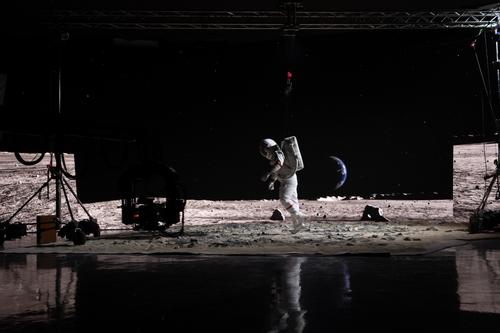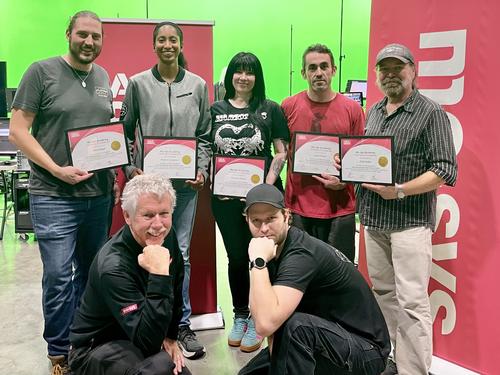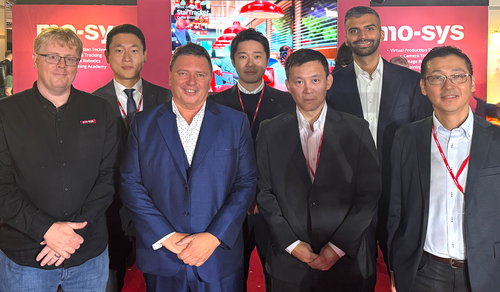CJP Broadcast Completes 4K-UHD Virtual Studio
CJP Broadcast has completed a new 4K-UHD virtual studio for the University of Sunderland.

The system includes a Mo-Sys StarTracker Studio with a camera tracking unit, wireless-linked handheld StarTracker Viewfinder and Cartoni JibO lightweight jib. CJP Broadcast has also provided and integrated Kinoflow Diva Lite 401 LED luminares and a Zero 88 FLX S24 lighting control desk, plus high-grade green-screen walls and flooring. The studio itself has a 6 x 6 metre floor area and is 4 metres high. Installed at the university’s David Puttnam Media Centre, the new resource gives students the opportunity to gain practical experience in latest-generation virtual studio production techniques.
"This investment opens up a whole new level of creative opportunities for students from across the faculty," commented Professor Arabella Plouviez, Academic Dean of the Faculty of Arts & Creative Industries. "The green hue of the new space can be digitally manipulated into any kind of environment – real or imagined – for film, TV, animation or photography. It will enable our students to really innovate with technology so new that the possibilities are still uncharted. This is an exciting new area for us to be leading in."
"Chroma key has long been a core element of our training courses," detailed the university's Senior TV Technician Craig Moore. "It is a production technique which has become increasingly useful in recent years, allowing broadcasters to achieve realistic graphic effects efficiently, affordably and with precise control. High quality processing is important given the very large number of television viewers now watching on large display screens.
"We chose StarTracker Studio because it gives us an all-in-one virtual production solution catering for broadcast multi camera and film-style scenarios as well as being ready for LED volume filming. Students today expect training in all those aspects. StarTracker Studio is a complete virtual production resource built around the industry-standard StarTracker camera tracking system. StarTracker Studio is capable of far more than the virtual backgrounds traditionally associated with chroma key. As well as placing static or dynamic scenes on the studio walls, it can superimpose photo-realistic 3D objects in front of presenters, allowing any type of virtual production.
"CJP also recommended and integrated a versatile and energy-efficient lighting system for use with our new background cyclorama. The cyc is constructed with a wide-radius curve at the corners and where the green-screen surface blends with the studio floor. That means we can deploy cameras from a wide range of angles.
"From the initial conception of this project to the date it needed to be completed was around four months. Missing this deadline could have resulted in us losing the investment. It was essential that we work with one company that could not only refurb the studio with a new wall and LED lights but also integrate the new VP technology in a very tight timescale. We realised we would need a lot of support to understand what this technology can do and integrate it into our teaching. Working with CJP gives us a single point of contact for support.
"We wanted to be able to offer something other universities currently can’t. The success of The Mandalorian television series, and the publicity about how it was created, opened our eyes to the process of live virtual production. Our hope was to replicate a similar type of setup which would position our university at the forefront of this new production method within the higher education sector. Our chroma key and TV studios are relatively small and have little or no storage space for sets. With this new system we can create large sets at no cost and turn our studios into anything our students can think of. This investment will also help us forge new relationships with external companies, whether it be production companies, football clubs, the local council or whatever. The main aim is to give our students every advantage possible for when they graduate, and help them gain employment in their chosen field."
"StarTracker is an exceptionally stable tracking technology based on small reflective stars which are random- ly applied to the studio ceiling," added CJP Broadcast Project Manager Kieran Phillips. "The stars are hardly visible to the naked eye. An LED emitter and sensor on the camera shines unobtrusive infra-red light on the stars, defining the star map which allows StarTracker to capture precise six-axis movement with lens focus and zoom data, all in real time. Once calibrated, the system is fully autonomous and starts tracking immediately on power-up. Because StarTracker is always referencing itself to its star map, its position is absolute and drift-free.
"StarTracker Studio is a complete three-camera 4K virtual studio system which can be expanded to source from up to eight cameras. Fully configured with pre-calibrated lenses, integral graphics processing and 4K recording, it transforms a compact studio space into a much larger virtual studio without need for physical set construction. The virtual production software used in StarTracker Studio is Mo-Sys’ VP Pro, which is embedded directly into the Unreal Engine’s editor interface. This architecture approach enables new versions of VP Pro to be released the same day as Epic releases new versions of Unreal Engine, meaning users have immediate access to new Unreal features.
"Using StarTracker Studio, virtual sets can be switched almost instantly and augmented to include remote guests or superimposed objects. Photo-realistic graphic capabilities include occlusion handling which allows a presenter to walk in front of or behind a virtual object, and reflection mapping which intelligently adds reflections to adjacent virtual objects. Among additional features are soft shadow lighting effects and depth-of-field lens emulation."
StarTracker Viewfinder in action in the new virtual studio
Also part of the installation, StarTracker Viewfinder is a wireless-linked handheld monitor that behaves like a virtual camera. It allows directors, video effects supervisors and cinematographers to frame a scene, create and practice camera moves without having to guess where the virtual objects are.
"This is the latest in a series of projects we have completed for the university sector," summarised CJP Broadcast managing director Chris Phillips. "We are fully confident that the system we have built in partner- ship with Craig and his colleagues at the University of Sunderland will provide both the theoretical understanding and practical skills graduates need to succeed in the modern world of media creativity."




